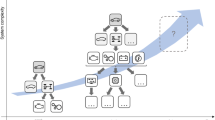Abstract
Compared with traditional software applications, the requirements problem of Internetware applications exhibits a set of new characteristics that cannot be resolved by traditional engineer-centered face-to-face requirements methods. In this paper, we present an exploratory approach to the requirements elicitation and evolution problem of Internetware applications, based on the concept of web-enable collective intelligence, to accommodate the situation of large-scale user communities of Internetware applications with diverse and constantly evolving requirements. In particular, we propose a feature-oriented stigmergy-based collaborative requirements modeling method that combines feature-oriented requirements modeling with web-enabled stigmergy-based collaboration to support large-scale collaborative requirements eliciting and evolving activities for Internetware applications. Two experiments are introduced to show the feasibility and effectiveness of this approach.
Similar content being viewed by others
References
Mei H, Huang G, Xie T. Internetware: a software paradigm for Internet computing. Computer, 2012, 45: 26–31
Gottesdiener E. Requirements by Collaboration: Workshops for Defining Needs. Boston: Addison-Wesley, 2002
Wiegers K E. Software Requirements. 2nd ed. Redmond: Microsoft Press, 2003
Robertson S, Robertson J C. Mastering the Requirements Process. 2nd ed. Boston: Addison-Wesley, 2006
Theraulaz G, Bonabeau E. A brief history of stigmergy. Artif Life, 1999, 5: 97–116
Griss M L, Favaro J, d’Alessandro M. Integrating feature modeling with the RSEB. In: Proceedings of 5th International Conference on Software Reuse, Victoria, 1998. 76–85
Kang K C, Cohen C, Hess J, et al. Feature-oriented Domain Analysis (FODA) Feasibility Study. Technical Report, Software Engineering Institute, Carnegie Mellon University. 1990
Kang K C, Kim S, Lee J, et al. FORM: a feature-oriented reuse method with domain-specific reference architectures. Ann Softw Eng, 1998, 5: 143–168
Benavides D, Segura S, Ruiz-Cortes A. Automated analysis of feature models 20 years later: a literature review. Inform Syst, 2010, 35: 615–636
Zhang W, Mei H, Zhao H. Feature-driven requirement dependency analysis and high-level software design. Requir Eng, 2006, 11: 205–220
Bonabeau E, Dorigo M, Theraulaz G. Swarm Intelligence: from Natural to Artificial Systems. New York: Oxford University Press, 1999
Grassé P. The reconstruction of the nest and inter-individual coordination among Bellicositermes natalensis and Cubitermes sp.: the theory of stigmergy. Insectes Soc, 1959, 6: 41–83
Malone T W, Laubacher R, Dellarocas C. The collective intelligence genome. MIT Sloan Manag Rev, 2010, 51: 21–31
Heylighen F. Collective intelligence and its implementation on the web: algorithms to develop a collective mental map. Comput Math Organ Theor, 1999, 5: 253–280
Bernstein A, Klein M, Malone T W. Programming the global brain. Commun ACM, 2012, 55: 41–43
Page L. Method for Node Ranking in Linked Database. US Patent, US6285999 B1, 2001
Linden G, Smith B, York J. Amazon.com recommendations: item-to-item collaborative filtering. IEEE Internet Comput, 2003, 7: 76–80
Zhang W, Zhao H, Mei H. A propositional logic-based method for verification of feature models. In: Proceedings of 6th International Conference on Formal Engineering Methods, Seattle, 2004. 115–130
Batory D. Feature models, grammars, and propositional formulas. In: Proceedings of 9th International Software Product Lines Conference, Rennes, 2005. 7–20
Object Management Group. Object Constraint Language (Version 2.2), 2010. http://www.omg.org/spec/OCL/2.2
Yi L, Zhao H, Zhang W, et al. CoFM: an environment for collaborative feature modeling. In: Proceedings of 20th IEEE International Requirements Engineering Conference, Chicago, 2012. 317–318
Potts C, Takahashi K, Anton A I. Inquiry-based requirements analysis. IEEE Softw, 1994, 11: 21–32
Boehm B W, Bose P, Horowitz E, et al. Software requirements as negotiated win conditions. In: Proceedings of 1st International Conference on Requirements Engineering, Colorado Springs, 1994. 74–83
Boehm B W, Bose P, Horowitz E, et al. Software requirements negotiation and renegotiation aids: a theory-w based spiral approach. In: Proceedings of 17th International Conference on Software Engineering, Seattle, 1995. 243–253
Boehm B W, Grunbacher P, Briggs R O. Developing groupware for requirements negotiation: lessons learned. IEEE Softw, 2001, 18: 46–55
Jarke M, Bui X T, Carroll J M. Scenario management: an interdisciplinary approach. Require Eng, 1998, 3: 155–173
Rolland C, Achour C B, Cauvet C, et al. A proposal for a scenario classification framework. Require Eng, 1998, 3: 23–47
Laurent P, Cleland-Huang J. Lessons learned from open source projects for facilitating online requirements processes. In: Proceedings of 15th International Working Conference on Requirements Engineering: Found for Software Quality, Amsterdam, 2009. 240–255
Castro-Herrera C, Cleland-Huang J, Mobasher B. Enhancing stakeholder profiles to improve recommendations in online requirements elicitation. In: Proceedings of 17th IEEE International Requirements Engineering Conference, Atlanta, 2009. 37–46
Cleland-Huang J, Dumitru H, Duan C, et al. Automated support for managing feature requests in open forums. Commun ACM, 2009, 52: 68–74
Decker B, Ras E, Rech J, et al. Wiki-based stakeholder participation in requirements engineering. IEEE Softw, 2007, 24: 28–35
Author information
Authors and Affiliations
Corresponding author
Rights and permissions
About this article
Cite this article
Zhang, W., Yi, L., Zhao, H. et al. Feature-oriented stigmergy-based collaborative requirements modeling: an exploratory approach for requirements elicitation and evolution based on web-enabled collective intelligence. Sci. China Inf. Sci. 56, 1–18 (2013). https://doi.org/10.1007/s11432-013-4912-8
Received:
Accepted:
Published:
Issue Date:
DOI: https://doi.org/10.1007/s11432-013-4912-8




